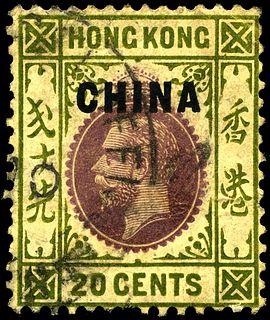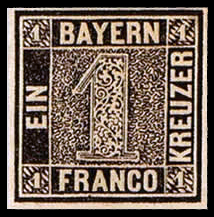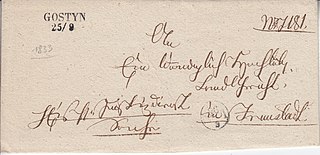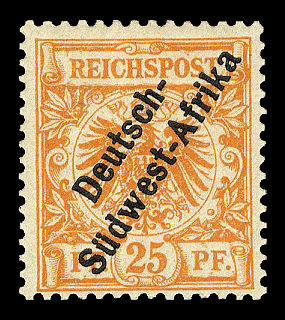
An overprint is an additional layer of text or graphics added to the face of a postage or revenue stamp, postal stationery, banknote or ticket after it has been printed. Post offices most often use overprints for internal administrative purposes such as accounting but they are also employed in public mail. Well-recognized varieties include commemorative overprints which are produced for their public appeal and command significant interest in the field of philately.

The French post offices in China were among the post offices maintained by foreign powers in China from the mid-19th century until 1922. The first French Post Office in China opened in 1862. Initially, the French government used ordinary French postage stamps for these offices. These forerunner stamps can be shown to have been sold or used in China only by a postmark. Stamps used at Shanghai prior to 1876, for example, can only be identified by diamond-shaped cancel made of a type referred to as a “losange à gros chiffres” with the numbers "5104" in the center of the cancel.

This is an introduction to the postal and philatelic history of Italy.
This is a survey of the postage stamps and postal history of the German territory of the Saar. As a border region contested between France and Germany, the Saar has a somewhat complicated philatelic history.

This is a survey of the postage stamps and postal history of German East Africa.

The Russian post offices in China were a collection of post offices established by Imperial Russia in various cities of China beginning in 1870.
Each "article" in this category is a collection of entries about several stamp issuers, presented in alphabetical order. The entries are formulated on the micro model and so provide summary information about all known issuers.

The British post offices in China were a system of post offices set up by the United Kingdom in various treaty ports of China in the late 19th and early 20th centuries.

The Yacht issue was a series of postage stamps, bearing the image of German Kaiser's yacht, SMY Hohenzollern II, that were used in all of Germany's overseas colonies. Millions of stamps were produced and they were the principal means of postage for all German imperial overseas possessions in the years 1900–1915. German colonies at that time were German Samoa, Kiautschou Bay, Togoland, Kamerun, German New Guinea, German South-West Africa, and German East Africa.

In general, philatelic fakes and forgeries are labels that look like postage stamps but have been produced to deceive or defraud. Learning to identify these can be a challenging branch of philately.

This is a survey of the postage stamps and postal history of Germany and philatelically related areas. The main modern providers of service were the Reichspost (1871–1945), the Deutsche Post under Allied control (1945–1949), the Deutsche Post of the GDR (1949–1990), the Deutsche Bundespost (1949–1995), along with the Deutsche Bundespost Berlin (1949–1990), and are now the Deutsche Post AG.

The Deutsche Post (DP), also Deutsche Post of the GDR was the state-owned postal and telecommunications monopoly of the German Democratic Republic. The DP was placed under the control of the Ministry for Postal and Telecommunication Services of the GDR(Ministerium für Post- und Fernmeldewesen der DDR - ) - a member of the Council of Ministers of the GDR(Ministerrat der DDR) - and was in operation from 1949 until the reunification of Germany on 3 October 1990.

The Deutsche Bundespost Berlin was the name used on the stamps of West Berlin. It sounds similar to the name of the Western German postal services Deutsche Bundespost and was de facto a dependency of it. De jure, it was independent and was called Landespostdirektion Berlin. The governmental agency to provide mail and telecommunication services for West Berlin. This civil service agency was in operation from 1949 until 1990.

Germania stamps are definitive stamps that were issued by the German Empire and the Weimar Republic between 1900 and 1922, depicting Germania. They represent the longest running series in German philately and are in their many variations and derivations an essential part of German philatelic collections.

The German post offices abroad were an extraterritorial network of German post offices in foreign countries with a significant German commercial interest to provide mail service where the local services were generally deemed unsafe or unreliable, such as China, Morocco, Ottoman Empire and Zanzibar. The system ended during or shortly after World War I.
The German post offices abroad were a network of post offices in foreign countries established by Germany to provide mail service where the local services were deemed unsafe or unreliable. They were generally set up in cities with some sort of German commercial interest. In early use only the cancellation mark can identify their postal use abroad; such stamps are known as "Vorläufer" (forerunner) stamps. Later stamps are identified by overprints even when not postally used. German abroad stamps started appearing in the late 19th century and reached their heyday at the beginning of the 20th century; they closed down during or shortly after World War I.

The German post offices abroad were a network of post offices in foreign countries established by Germany to provide mail service where the local services were deemed unsafe or unreliable. They were generally set up in cities with some sort of German commercial interest. In early use only the cancellation mark can identify their postal use abroad; such stamps are known as "Vorläufer" (forerunner) stamps. Later stamps are identified by overprints even when not postally used. German abroad stamps started appearing in the late 19th century and reached their heyday at the beginning of the 20th century; they closed down during or shortly after World War I.

This is a survey of postage stamps and postal history of the German colonies and part of the postage stamps and postal history of Germany, as well as those of the individual countries and territories concerned.

Poczta Polska, the Polish postal service, was founded in 1558 and postal markings were first introduced in 1764. The three partitions of Poland in 1772, 1793 and 1795 saw the independent nation of Poland disappear. The postal services in the areas occupied by Germany and Austria were absorbed into those countries' postal services. In 1772 the area occupied by Austria was created into the Kingdom of Galicia, a part of the Austrian Empire. This lasted till 1918. The Duchy of Warsaw was created briefly, between 1807 and 1813, by Napoleon I of France, from Polish lands ceded by the Kingdom of Prussia under the terms of the Treaties of Tilsit. In 1815, following Napoleons' defeat in 1813, the Congress of Vienna, created Congress Poland out of the Duchy of Warsaw and also established the Free City of Kraków. Congress Poland was placed under the control of Russia and the postal service was given autonomy in 1815. In 1851 the postal service was put under the control of the Russian post office department regional office in St Petersburg. In 1855 control was restored for a while to the Congress Kingdom but following the uprising in 1863 again came under Russian control from 1866 and continued until World War I. In November 1918 the Second Polish Republic was created.

German South West Africa was a German colony in Africa, established in 1884 with the protection of the area around Lüderitz and abandoned during World War I, when the area was taken over by the British.


















